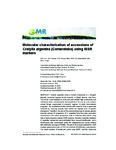Por favor, use este identificador para citar o enlazar este ítem:
http://www.alice.cnptia.embrapa.br/alice/handle/doc/1030223Registro completo de metadatos
| Campo DC | Valor | Lengua/Idioma |
|---|---|---|
| dc.contributor.author | LUZ, G. A. | pt_BR |
| dc.contributor.author | GOMES, S. O. | pt_BR |
| dc.contributor.author | ARAUJO NETO, R. B. de | pt_BR |
| dc.contributor.author | NASCIMENTO, M. S. C. B. | pt_BR |
| dc.contributor.author | LIMA, P. S. da C. | pt_BR |
| dc.date.accessioned | 2015-12-01T11:11:11Z | pt_BR |
| dc.date.available | 2015-12-01T11:11:11Z | pt_BR |
| dc.date.created | 2015-12-01 | pt_BR |
| dc.date.issued | 2015 | pt_BR |
| dc.identifier.citation | Genetics and Molecular Research, Ribeirão Preto, v. 14, n. 4, p. 15242-15248, nov. 2015. | pt_BR |
| dc.identifier.issn | 1676-5680 | pt_BR |
| dc.identifier.uri | http://www.alice.cnptia.embrapa.br/alice/handle/doc/1030223 | pt_BR |
| dc.description | Cratylia argentea (Desv.) Kuntze (Fabaceae) is a drought-tolerant, perennial legume found primarily in Brazil, Bolivia, and Peru. The shrub is well adapted to acid soils and exhibits high productivity and nutritional value, characteristics that would favor its use as a dry season animal forage supplement in semiarid regions. In plant improvement programs, the production of elite hybrids with superior traits is generally achieved by crossing parents that exhibit the highest level of genetic divergence. Therefore, the aim of the present study was to assess genetic diversity among 13 accessions of C. argentea from the same population maintained in the active germplasm bank of Embrapa Meio-Norte using inter-simple sequence repeat (ISSR) markers. Genetic similarities between C. argentea accessions were estimated from Jaccard coefficients, and a dendrogram was constructed using the unweighted pair group method with arithmetic average (UPGMA). The set of 15 primers selected for ISSR analysis generated a total of 313 loci of which 79.23% were polymorphic. The mean number of bands per primer was 20.87, and the amplicons ranged from 280 to 3000 bp in size. Primers UBC834 and UBC827 generated the largest number of polymorphic loci and exhibited 90.91 and 100% polymorphism, respectively. The coefficients of genetic similarity among accessions varied between 0.49 and 0.73. UPGMA cluster analysis allowed the identification of four genotypic groups and demonstrated the existence of considerable variability within the collection. Potential progenitors were selected that would offer good possibilities of obtaining unusual and favorable combinations of genes in a plant breeding program. | pt_BR |
| dc.language.iso | eng | eng |
| dc.rights | openAccess | eng |
| dc.subject | Caracterização molecular | pt_BR |
| dc.subject | Diversidade genética | pt_BR |
| dc.subject | Forage crop | pt_BR |
| dc.subject | Genetic diversity | pt_BR |
| dc.subject | ISSR markers | pt_BR |
| dc.subject | Molecular characterization | pt_BR |
| dc.title | Molecular characterization of accessions of Cratylia argentea (Camaratuba) using ISSR markers. | pt_BR |
| dc.type | Artigo de periódico | pt_BR |
| dc.date.updated | 2016-02-24T11:11:11Z | pt_BR |
| dc.subject.thesagro | Planta forrageira | pt_BR |
| dc.subject.thesagro | Marcador molecular | pt_BR |
| riaa.ainfo.id | 1030223 | pt_BR |
| riaa.ainfo.lastupdate | 2016-02-24 | pt_BR |
| dc.identifier.doi | http://dx.doi.org/10.4238/2015.November.25.12 | pt_BR |
| dc.contributor.institution | G.A. Luz, Laboratório de Biologia Molecular, Centro de Ciências Agrárias, Universidade Federal do Piauí, Teresina, PI.; S.O. Gomes, Laboratório de Biologia Molecular, Centro de Ciências Agrárias, Universidade Federal do Piauí, Teresina, PI.; RAIMUNDO BEZERRA DE ARAUJO NETO, CPAMN; M.S.C.B. Nascimento, APOSENTADA; PAULO SARMANHO DA COSTA LIMA, CPAMN. | pt_BR |
| Aparece en las colecciones: | Artigo em periódico indexado (CPAMN)  | |
Ficheros en este ítem:
| Fichero | Descripción | Tamaño | Formato | |
|---|---|---|---|---|
| ArtigoSarmanhoGMR6985cam.pdf | 506,66 kB | Adobe PDF |  Visualizar/Abrir |









